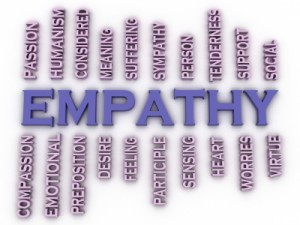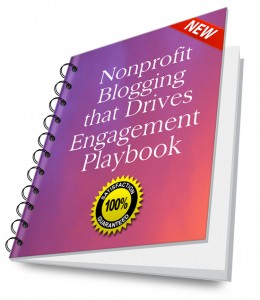I recently learned about Van Jones’ virtual reality experiment, Day of Empathy via this video (thank you, thank you, thank you to Nancy Schwartz for writing about this on her Getting Attention nonprofit marketing blog: OMG Experiment to Connect & Activate (Dream Corps Case Study). The idea is to use virtual reality to build empathy (i.e., to help people walk in the shoes of others) in order to motivate action.
The idea of using virtual reality to build empathy on a communal scale is brilliant!
And it ties back to Darwin’s theory of survival.
It is a little-known fact that Darwin’s work, erroneously labelled as “survival of the fittest,” was really about survival of the most empathic. What he found was that those communities that took care of one another were those that survived. Those communities were the most “fit.” (Darwin used Herbert Spencer’s term, “survival of the fittest,” only twice in all of his writings; somehow, that’s what stuck). In fact Darwin argues that we are a profoundly social and caring species, with sympathy being a stronger instinct than self-interest (see Born to Be Good: The Science of a Meaningful Life by Dacher Keltner.)
Presumably the central role empathy plays within our society was codified numerous times in different variations of “The Golden Rule.” Why? Because people throughout time and space recognized that our survival depends on the capacity to mentally trade places with another fellow human being.
The communities that survive are those that are most empathic.
Sadly, empathy seems to be something sorely lacking among many in today’s world. And we need it more than ever.
Anita Nowak of McGill University states:
Society needs to undergo an empathic revolution if we are to survive as a species… we must engage with empathy; not as spectators, but as fully involved participants. [The state of society today makes] the moral imperative to act explicit. We are facing a set of social and environmental crises that are unprecedented… we are beset by wicked problems.”
Nowak notes there is a spectrum of empathy, with pity at one end, empathy at the other and compassion and sympathy somewhere in between. Pity, while being an emotional reaction to someone’s pain, also involves an element of looking down on people (she believes this is the genesis of a lot of foreign aid and paternalistic philanthropy.) Empathy recognizes our shared humanity and inherent worth. Extending empathy, Nowak continues, is the only human emotion that expresses equality between humans.
Many of the ways we connect today are one-dimensional, making empathy difficult to access.
Though ostensibly we’re more networked than ever thanks to digital technology, the types of connections folks have with one another sometimes lack a human dimension. We’re so bombarded with news that it can have a numbing effect. We’re exposed to video games and social media replete with violence and bigotry. There’s so much of it that it fades into the background, making us blind and deaf to human suffering.
Inability to empathize threatens our survival.
Evolutionarily, empathy grew out of the ability to understand and respond to cries of distress from others. Frans B. M. de Waal, Ph.D., a primatologist and author of Our Inner Ape and The Age of Empathy: Nature’s Lessons for a Kinder Society, tells of a deaf female chimpanzee who gave birth to a succession of infants and had intense positive interest in them. But because she was deaf, she wouldn’t notice her babies’ calls of distress — even if she sat down on them. This illustrates that without the proper mechanism for understanding and responding to a child’s needs, a species will not survive.
Understanding is an important underpinning of empathy, and an antidote to bigotry and indifference.
Merriam-Webster defines a bigot as “a person who strongly and unfairly dislikes other people, ideas, etc; a person who hates or refuses to accept the members of a particular group.”
Most of us don’t think of ourselves as bigots, but many of us have difficulty really accepting people we see as different. It’s hard to embrace those who you’ve never met and who you don’t begin to understand.
De Waal suggests that if we could manage to see people on other continents as part of us, drawing them into our circle of reciprocity and empathy, we would be building upon, rather than going against, our nature.
He writes about the Israeli Minister of Justice, Yosef Lapid, who in 2004 caused political uproar for sympathizing with Palestinians whose homes were being demolished by Israeli soldiers. Lapid said: “When I saw a picture on the TV of an old woman on all fours in the ruins of her home looking under some floor tiles for her medicines, I did think, ‘What would I say if it were my grandmother?’ Lapid’s grandmother was a Holocaust survivor.
This incident shows how empathy can widen the definition of one’s group. Lapid realized Palestinians were part of his circle of concern, too. De Waal writes:
Empathy is the one weapon in the human repertoire that can rid us of the curse of xenophobia.
Virtual reality could have the power to introduce us to our neighbors, near and far.
All good fundraising and nonprofit marketing attempts to do this. By writing stories to acquaint us with people in need. By showing us how folks got into the dire straits in which they are in. By making us feel “there, but for the grace of God, go I.” By making us want to help, because we identify with other people’s feelings, thoughts and actions and empathize with their situation.
The big challenge comes with globalization. Our evolutionary background (fighting over limited resources) made it expedient to hate our enemies, ignore people we barely knew, and distrust those who didn’t look like us. Even if we’re cooperative within our communities, we become quite different in our treatment of strangers – with whom we find it difficult to identify.
What if we wanted to help all of our neighbors, because we identified with each and every one?
That would be a community that would survive. Big time.
Can you imagine it?
Begin on a local scale.
Imagine what would it be like to live in a project where you’re intimidated by gangs? To see your mother shot? To be thrown into prison as a teen-ager? To only see your father when you visit him in prison?
Van Jones and the Dream Corps are focusing on helping folks do more than just imagine these things; they want to help them feel them.
They’ve selected prison reform as their empathy issue. They’re creating three virtual reality (VR) experiences, and recruiting hundreds of “Ambassadors of Empathy” who on February 8, 2017, will bring VR headsets into all 50 state capitols and the U.S. Congress and ask thousands of policy-makers to don the headsets. Through the VR shorts, key decision-makers will experience the human consequences of a criminal justice system. They hope this will build the empathy needed to drive bipartisan action.
One can envision using this technique on a global scale as well.
Virtual reality is often referred to as an “empathy machine.”
Machines do things efficiently and quickly, which is just what the doctor ordered in today’s zeitgeist.
What’s incredible about the “Day of Empathy” experiment is how it addresses current trends and challenges. The information overload that causes folks to fail to notice things. The shortening of attention spans that comes from inundation and exposure to multiple stimuli. The trend towards visual content marketing, because people no longer have time or inclination to read.
Nancy Schwartz suggests that “using virtual reality to build empathy—the first step to engagement and action—could be groundbreaking.” I have to agree.
We have to humanize the narrative and make it easily accessible.
On a meta-level, empathy may be the foremost survival skill of the current age — and the very best way to change the world.
What are you doing to humanize your communications with supporters and would-be supporters? Please share in the comments below.
HOW TO WIN FRIENDS AND INFLUENCE PEOPLE
One of the best ways to humanize the narrative, and tell your nonprofit’s stories, is through a blog. Learn why this works so well, and how you can do it, with my Nonprofit Blogging that Drives Engagement Playbook. I promise it’s not that difficult, and it’s well worth the effort. In my book, any tool that accomplishes multiple objectives simultaneously is a winner. Learn more here. If you’re a paid Clairification subscriber, you get an additional 50% off! Plus, I stand by all my Clairification products. If you’re not happy, there’s a no questions asked full refund policy. T.
Image courtesy of freedigitalphotos.net







For a cornucopia of resources on empathy see the Center for Building a Culture of Empathy. http://CultureOfEmpathy.com
We invite you to join the International Empathy Trainers Association
http://j.mp/Empathy-Trainers-Association
warmly
Edwin
Director: Center for Building a Culture of Empathy
Thanks for the great resources Edwin. Appreciate it!
Involving the community brings about significant changes and supports empathy. At our local Food Bank we work on community investment. Our pantries are mostly local churches where the congregation distribute the Food. We are one of a few agricultural food banks where local residents, businesses, civic organization, schools etc spend a morning in the fields gleaning. You shouldn’t be shocked to see our local Congressman or the family and Governor of Virginia next to you picking. Our collaboration with local farmers and produce growers to provide nutritional, healthy, local produce. Through our network and collaboration in our Rural communities we work together to feed local residents in need or sorting in the warehouse for distribution. Our clients trust our partnering pantries and the Food Bank to provide not only food but respect. Our Food Bank is not about more than Food. It’s having relationships, looking our clients in the eye and knowing about them to support their other needs and providing resources with other organizations. Check us out at http://www.nnfb.org
Great feedback Julie. Having worked for a food bank, I know how people connect to this issue on a gut level. For other types of causes, it’s not always as easy. But it’s equally important. And doable.
Very interesting article. Thanks for sharing, Julie!
Claire, wonderful piece! So many great points here about empathy and reframing what we do to really connect with people. I want to see this concept applied everywhere, and for generations. It’s not just a lesson for nonprofit professionals. It’s a lesson for politics, travel and life in general. Simply put, we must take care of one another if we want to avoid going extinct. Consider this post shared. Thank you and keep it up!
Claire, I must sincerely confess that all the things you keep on mentioning in your articles accurately reflect the negative attitudes of our people in social positions of trust here in Sierra Leone. I appreciate you talent and your true sense of purpose to help change the world in your own way. Make no mistake I will surely keep on monitoring and reading your posts with a sense of nationalistic purpose to pass them over to the majority of our nationals especially the youth who are left with no future and they are now using their youthful energies in the wrong way. To help effect peaceful positive change from within that will help us move forward in a number if tangible ways I consider your articles as absolutely relevant to effect the much required change we need in our country before the politicians finally wreck our nation